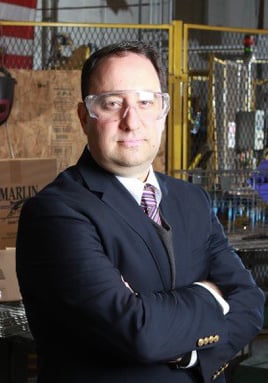Protecting Manufacturing’s Core: Big Issues Facing Small Manufacturers, and Optimism for the Future
When one thinks of the manufacturing industry, names like Mercedes-Benz, Whirlpool, Michelin, Caterpillar and Siemens may come to mind. And while the giants of the manufacturing world are vital to the industry overall, the fact is, the vast majority of manufacturers in the United States fall into the “small-to-medium-sized” category—with the average company employing just under 20 people.

The enormity of this manufacturing sector is clear, considering that out of the roughly 251,000 manufacturers in America, about 221,000 of them are considered “small-to-medium-sized.” These companies are the backbone of the supply chain, making the parts and products that enable their larger counterparts to compete, grow and thrive. They are the driving force behind research and development, spending an enormous amount of time and resources on innovating the parts and products of tomorrow. They are job creators, providing millions of Americans with stable, well-paying jobs, health insurance and retirement benefits. And this sector’s contributions to the economy—locally, nationally and globally—are substantial. Recent data shows that manufacturing contributed $2.17 trillion to the U.S. economy, representing 12.1 percent of our country’s gross domestic product. This simply would not be possible without the contributions of small-to-medium manufacturers, who constitute nearly 90 percent of the industry.
Drew Greenblatt is president and owner of a manufacturing business that falls into this category: Marlin Steel Wire Products—a leading maker of custom wire products for the aerospace, automotive, medical and pharmaceuticals industries. He also sits on the Board of Directors for the National Association of Manufacturers (NAM) as chair of its small-to-medium manufacturers group. Greenblatt says manufacturers of this size are the very essence of American manufacturing, so it’s vital to understand and address the issues facing them. At the top of the list: the high U.S. corporate tax rate.
“Right now, the average American factory is what’s called a pass-through, an S-corp or an LLC,” said Greenblatt. “We’re paying taxes at around 40 percent, and that doesn’t include health insurance.”
Greenblatt says manufacturers of this size are also burdened by a laundry list of government regulations that add little or no value, and come at a high price. While he believes some regulation is necessary—like those aimed at keeping our water and environment clean—others amount to nothing more than expensive paper-pushing.
“Because of regulation, for example, my bank is forced to require that I do a physical inventory audit, which costs me $8,000 a year,” said Greenblatt. “They take the audit paperwork, email it to a regulator, who then puts it on a shelf, only to prove that they have done it.”
A study commissioned by NAM revealed that the cost of federal regulations falls disproportionately on manufacturers, particularly the smaller companies. Small manufacturers with less than 50 employees spend more than double the amount that large manufacturers do on meeting government regulations.

Deanna Nelson is the operations director for Johnan America, Inc., a tier one supplier to the automotive industry employing some 200 people in the U.S. She agrees the burden of government regulations on smaller manufacturers is a top issue, but she’s equally as concerned about the growing skills gap in the American workforce. Nelson says more needs to be done to encourage students to pursue jobs in manufacturing right out of high school.
“It’s our number one issue,” said Nelson. “We can’t seem to find the skilled labor who want to work in manufacturing.”

But with a new Congress and administration on Capitol Hill, both Greenblatt and Nelson are optimistic that meaningful changes are coming.
“I think the new administration has the means to get things done,” said Nelson. “Not everyone will agree with these changes, but they should be good for businesses and the economy. I feel very optimistic and positive that we are heading in the right direction.”
Tom Riordan, who previously led NAM’s small-to-medium manufacturers group and is president of Neenah Enterprises, is a bit more cautiously optimistic about the new administration’s ability to significantly improve the business climate for small-to-medium manufacturers.
“The Trump administration’s proposal is that for every one new regulation, two will be taken away,” said Riordan. “I applaud the intent, but we’ll see how, from a practical standpoint, that turns out. But I think on a broad basis, suggesting that the administrative burden is not going to get worse in 2017 is significant.”
Riordan also cautioned that changes to government regulations should be thoughtful in order to be sustainable, and that forcing changes too quickly could be met with fierce opposition.
“When it comes to things like workplace safety, we take real pride in making sure we keep our folks safe,” said Riordan. “So I’m not looking to change that fundamental mindset. But, on the other hand, some of these rules and regulations are cost penalties with no real discernible benefit.”

The Alliance for American Manufacturing (AAM) studies and makes recommendations for public policies that will strengthen American manufacturing. President of AAM, Scott Paul, pointed to slow growth in the U.S. economy as having a long-term impact on small-to-medium manufacturers.
“Outside of the automotive sector, which is doing particularly well, the U.S. economy has seen slow growth,” said Paul. “When there is slow economic growth, that means demand for products slows as well, and that certainly has an impact on small and mid-sized manufacturers.”
Paul says smart manufacturing policy doesn’t focus on a single issue, but is multi-faceted.
“Aspects of that policy include investing in our workforce, which includes a results-oriented trade policy that’s going to open markets overseas and also make sure we have very fair competition here in the U.S.,” said Paul.
He says when it comes to negotiating trade agreements, the U.S. could be doing a much better job.
“It’s been more than 20 years since the North American Free Trade Agreement was signed. Certainly we could make improvements to that. We face more competitive pressure from countries like Mexico, Canada and China that didn’t really exist when NAFTA was negotiated. We can benefit from the experience and make it a better agreement—one that’s going to create more jobs in the U.S.”
Paul shares optimism for new manufacturing policies that will positively impact small-to-mid-sized manufacturers with a new administration and Congress, but says growth in an industry like manufacturing is out of the control of any one lawmaker.
“One significant factor that impacts the climate for manufacturers is where we are in the business cycle,” Paul explained. “We’ve had a long and sustained period of job growth, and slow but steady economic growth, so that’s been positive. But, these cycles don’t last forever.”
He says that the policies of our global trading partners also significantly impact the business climate here at home.
“Are other countries growing their consumer classes who will buy more of our products, or are they doubling down on exporting their way to prosperity instead of having internal consumption as well? Those are all things that will have a significant impact on the future of U.S. manufacturing.”
- Category:
- GrayWay
- Food & Beverage
- Manufacturing
Some opinions expressed in this article may be those of a contributing author and not necessarily Gray.

